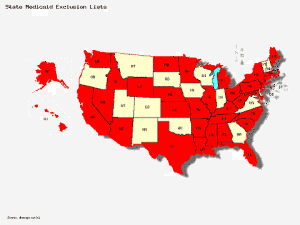Which Exclusion Lists Need to Be Screened? What Is the Difference between Them?
There are two federal databases that list persons and entities that have been excluded from participating in federal health care programs or receiving federal contracts. Checking and verifying individuals on the List of Excluded Individuals and Entities (LEIE) and the System for Award Management (SAM) should be part of any compliance exclusion screening program. The LEIE is maintained and updated by the Office of Inspector General for the Department of Health and Human Services (HHS-OIG), and the SAM consolidates several procurement based databases.
Many states (37 as of today) also have their own individual databases which list individuals and entities that have been excluded from participating in their State Programs (such as Medicaid) or receiving any State contracts. We’ll briefly discuss the difference between these exclusion lists and explain why each should be screened.
I. OIG Exclusion List (LEIE)

The OIG exclusion list, LEIE, is maintained specifically for the purpose of listing all persons and entities that have been excluded from participating in the Medicare program. It is comprised of all persons currently excluded from the program by the OIG and is updated monthly. The list contains the name of the excluded individual or entity at the time of the exclusion, the provider type, the authority under which the individual was excluded, and the state where the excluded individual resided at the time of the exclusion. The LEIE can be accessed on the OIG’s website and up to five names can be searched at a time. It can also be downloaded for searching purposes. Matches can then be verified individually by Social Security Number.
It is important to remember that the LEIE is prepared and maintained by HHS for the specific purpose of identifying persons or entities that have been excluded from the Medicare Program by its Inspector General. Therefore, it will not contain persons or entities on other exclusion lists if, for instance, the information was never forwarded to it, or if the basis of that exclusion was insufficient to support one from the LEIE.[1]
II. GSA-SAM
The SAM is an attempt by the federal government to consolidate several pre-existing procurement systems and combine them with the Catalog of Federal Domestic assistance. It is being done in phases. The first phase combined the functionality of the systems that listed persons or entities that were debarred, sanctioned, or excluded for contract or other fraud into a single searchable database. These were the Central Contractor Registry (CCR), Federal Agency Registration (FedReg), Online Representations and Certifications Application (ORCA), and the Excluded Parties List System (EPLS).
The SAM uses four exclusion classifications: Firm, Individual, Vessel, and Special Entity Designation. It also uses four exclusion types: Ineligible (Proceedings Pending), Ineligible (Proceedings Completed), Prohibition/Restriction, and Voluntary Exclusion.[2] There is significant overlap between the SAM and the LEIE. However, they were both created by several different agencies, and each has its own specific administrative process. It is not surprising that there are large gaps between them, and that they are ultimately very different in composition.
III. State Medicaid Exclusion Lists
 In addition to the LEIE and SAM, thirty-seven states (plus the District of Columbia) have their own Medicaid Exclusion Lists. These states are identified in red in the map to the left. In addition to being excluded from the specific states in which a person or entity is listed, Section 6501 of the Affordable Care Act (ACA) mandates that if a provider or entity is excluded under any state Medicaid database, then that provider or entity should be excluded from participating in all states.[3] State lists typically contain exclusions based upon licensing issues and many of these exclusions are not found on the LEIE, SAM or other state Lists. This occasionally occurs because the exclusion is based on a violation of a particular state statute. It also occurs because many states have inadequate processes to communicate exclusions to either the Federal Databases or their sister states.
In addition to the LEIE and SAM, thirty-seven states (plus the District of Columbia) have their own Medicaid Exclusion Lists. These states are identified in red in the map to the left. In addition to being excluded from the specific states in which a person or entity is listed, Section 6501 of the Affordable Care Act (ACA) mandates that if a provider or entity is excluded under any state Medicaid database, then that provider or entity should be excluded from participating in all states.[3] State lists typically contain exclusions based upon licensing issues and many of these exclusions are not found on the LEIE, SAM or other state Lists. This occasionally occurs because the exclusion is based on a violation of a particular state statute. It also occurs because many states have inadequate processes to communicate exclusions to either the Federal Databases or their sister states.
IV. Conclusion
The LEIE, SAM, and State Medicaid databases were all created by different entities for different reasons. They have different exclusion criteria and though they address concerns that may be similar in nature, the information is often agency specific. Ultimately, the lists often contain different entities and persons. Considering these differences and the severity of the risk of employing excluded persons, we strongly recommend conducting monthly searches of all of these databases. Contact the exclusion experts at Exclusion Screening, LLCSM by calling 1-800-294-0952 or fill out our online service form.
Ashley Hudson, Associate Attorney at Liles Parker, LLP and former Chief Operating Officer for Exclusion Screening, LLC, is the author of this article.
[1] For more information see other discussions within our site on the effects of exclusion and the publication by the U.S. Dep’t of Health and Human Servs. Office of the Inspector Gen., Special Advisory Bulletin on the Effect of Exclusion from Participation in Federal Health Care Programs, 13 (May 8, 2013).
[2] When EPLS was consolidated into SAM in July 2012 Cause and Treatment (CT) codes were eliminated. For more information on the transformation see Changes from EPLS to SAM on the SAM website at https://www.sam.gov/sam/transcript/Quick_Guide_for_Changes_From_EPLS.pdf.
[3] 42 U.S.C. 1396(a) (2012). Whether an exclusion by one state actually “excludes” an individual from all states or makes him “excludable” from all states is an open question at present, but why take the chance of hiring a person who has been excluded in another State if you don’t have to?



